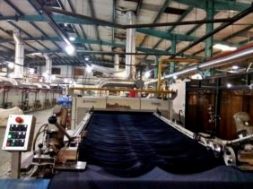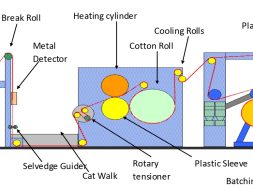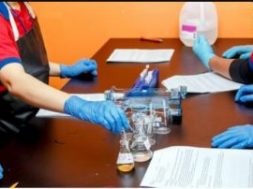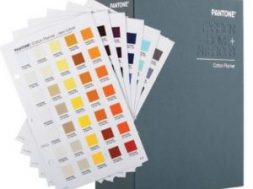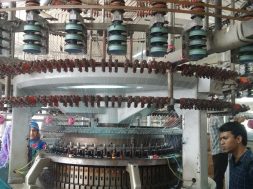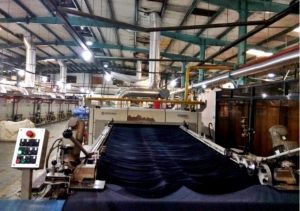
Textile Finishing | Stenter Machine
Textile Finishing | De-watering Machine | Slitting Machine | Dryers | Sueding Machine
Textile Finishing | Stenter Machine
Stenter Machine :
The most universal fabric drying machine is the stenter, which is usually the most expensive and indispensable machine in the finishing works. The presence of at least two stenters is mandatory in any textile finishing unit as almost all of the processed fabrics need stentering. Stenter drying provides the ideal opportunity to achieve weft straightening and edge uncurling, and the appropriate mechanisms are fitted at the entry end.
The essential characteristics of a stenter are the two driven chains carrying pins (or clips) to hold the fabric edges for passage through the enclosed drying compartments. Guiding arrangements are designed for accurate pinning of the edges, with provision for overfeeding the fabric to allow any required adjustment of fabric length while the width is increased to the precisely specified value.
Clip stenters are useful for dense and heavy fabrics that tend to damage pins, but overfeeding is not possible. The number of drying compartments, each typically 3 m long, depends on the speed required but is usually between three and eight. The tapering entry section is 5–7 m long and the delivery section another 5 m, to allow cooling to occur before removal for batching (or plaiting). A total length of 30 m, plus fabric feeding arrangements and batcher space, is therefore common and speeds of 100 m min–1 often achieved.
The main parts of a stenter are :
1. Feed Zone:
- Centering device
- Padding mangles
- Guide rollers

Fig : Feed zone, padding zone and bowing control zone
Fabric is at first put into the feed zone, which passes the fabric through the padding zone.
2. Chemical Padding Zone:
- Chemical tank
- Squeezing roller
In the padding zone, the fabric is passed through a tray containing softening chemicals in such a way that the fabric becomes completely soaked in softeners. A maximum of 250- 300kg fabric can be fed without refilling the chemical tank. The squeezing rollers then squeeze out the excessive softener and pass the fabric through the bowing control zone.
3. Bowing Control Zone :
- Rubber bowing roller
- Sensor
- Expanded steel roller
The bowing rollers fixes the bowing angles and reduces spirality of the fabric and the steel rollers move to and fro to control the horizontal stripes of striped fabrics.
4. Chain Entry Zone:
- Sensor
- Brush roller
- Overfeed roller
- Selvedge uncurlers
- Pinning wheels
- Pinned chains
- Moving rails

The fabric passes over the under-feed or feed-in roller, guide roller to the overfeed roller. The fabric then passes through selvedge uncurlers and is gripped on the pins of the moving rail by pinning wheels. The chain rail controls the fabric GSM with the same mechanism of a chain dryer mentioned earlier.
5 . Drying Zone
- Internal gas burner
- Blower
- Air ducts

The drying zone is responsible for drying the fabric and also for heat setting of spandex. Heat setting on a stenter involves 200°C applied for spandex containing fabrics like spandex S/J and 180°C for PES majority containing fabrics. For curing, temperature increases gradually and the curing temperature is fixed for the last 4 chambers in an 8 chamber stenter.
6. Cooling Zone :
- Cooling rollers
Water and air cooler rollers are responsible for cooling down the freshly dried hot fabric that comes from the drying zone.
7. Delivery Zone :
- To and fro plaiting system
With the help of a to and fro plaiting system, the fabric is piled and folded and is ready for further processing.
 Fig : Drying zone
Fig : Drying zone
Functions of a Stenter :
- To control the shrinkage of the fabric both widthwise and lengthwise
- To control the length of the fabric
- To control the width of the fabric according to the required length
- To dry the fabric
- To cure the fabric
- To control the fabric GSM
- To heat set spandex fiber containing fabric
Controlling Parameters :
- Fabric speed
- Fabric temperature
- Chamber temperature
- Overfeed (%)
- Fabric width adjustment
Setting parameters for different of knit fabric :
| Fabric type |
Overfeed speed % |
Temperature (°C) |
Machine speed (m/min) |
Padder pressure (bar) |
Softener dosing (g/l) |
|
| S/J | White | 10-15 | 120-140 | 25-35 | 2-2.5 | 30 |
| Dyed | 140-160 | |||||
| Rib | White | 25-30 | 120-140 | 25-35 | 2-2.5 | 30 |
| Dyed | 140-160 | |||||
| S/J cotton with spandex | White | 40-60 | 120-140 | 25-35 | 2-2.5 | 30 |
| Dyed | 140-160 | |||||
| Polo pique | White | 60-80 | 120-140 | 25-35 | 2-2.5 | 30 |
Textile Finishing | De-watering Machine | Slitting Machine | Dryers | Sueding Machine
(302)
